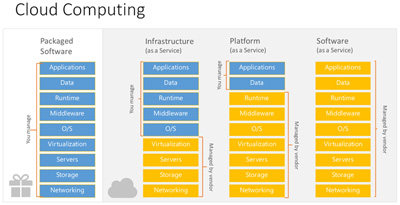By Van Beach
 Cloud computing is a somewhat nebulous term that generally refers to the shared use of a large, centralized pool of computing resources, accessible via the Internet. Resources are on-demand, pay-per-use, and highly scalable. IaaS (Infrastructure as a Service), PaaS (Platform as a Service), and SaaS (Software as a Service) are three common, but not well-understood terms used frequently when talking about cloud computing. They sound very similar and it’s very easy to assume since they are all related to the cloud that they are the same. They are NOT. So when a software claims the ability to “run in the cloud,” it is critical to understand the difference between these terms.
Cloud computing is a somewhat nebulous term that generally refers to the shared use of a large, centralized pool of computing resources, accessible via the Internet. Resources are on-demand, pay-per-use, and highly scalable. IaaS (Infrastructure as a Service), PaaS (Platform as a Service), and SaaS (Software as a Service) are three common, but not well-understood terms used frequently when talking about cloud computing. They sound very similar and it’s very easy to assume since they are all related to the cloud that they are the same. They are NOT. So when a software claims the ability to “run in the cloud,” it is critical to understand the difference between these terms.
Why does an actuary need to understand this technical jargon? Quite simply because actuaries rely heavily upon software and are directly involved in, and impacted by, actuarial software decisions. As actuarial software embraces cloud computing, actuaries need to recognize and understand that there are distinctly different approaches to “running in the cloud” and each has cost, performance, service levels, and overall value implications.
Let’s explore the case of actuarial modeling software to illustrate the differences between IaaS, PaaS and SaaS. Most actuaries with responsibilities for pricing, business planning, asset-liability management, reserve calculations, assessment of capital levels, cash-flow testing, and other actuarial analyses use software to assist with these calculations. Actuarial modelers are keenly aware that with the movement towards stochastic analyses and more complex models, runtime requirements have exploded. The ability to utilize grid computing—distributing calculations across hundreds, and often thousands, of computers—has become a critical and costly aspect of actuarial modeling. The cloud offers an opportunity to reduce the cost and burden of providing this grid infrastructure to support the actuarial software.
It is at this point where the actuary needs to understand IaaS, PaaS and SaaS because they are very different approaches to harnessing the cloud for actuarial grid computing.
IaaS provides the opportunity to outsource the hardware. This is an attractive option because hardware is a significant portion of the cost of grid computing. By moving to a variable cost, highly scalable model, a grid environment can be provided that better meets the peaks and valleys of actuarial demand at a lower cost than with a fixed grid. In this scenario, the company would be responsible for provisioning the hardware, setting up the operating systems, databases, and other aspects of the environment, as well as installing the actuarial software. The company would also be responsible for maintaining this environment. The actuary will benefit from the scalability and variable cost, but this benefit is limited by the lack of control. The computing resources must be provisioned and maintained—typically by the IT department—so the actuary is not directly in control of cloud infrastructure. Of the three approaches, IaaS provides the least business value and requires the highest level of IT involvement.
PaaS expands upon the hardware provided as part of IaaS to provide a more complete package including all of the networking, storage, security, and other components needed to support an application. This reduces the burden on the company when provisioning as well as maintaining the environment for the application. But while the burden is reduced, the responsibility still falls on the company to provision and manage the environment, including ensuring the application is running properly. The actuary again gets the benefit of scale and variable cost, but still is dependent upon others to provision the resources. PaaS provides more business value than IaaS and requires less IT involvement.
SaaS is a deployment model where the application is provided as a turnkey operation. The application, platform, and infrastructure are all provided as a single package. This single point of control enables the software service provider to optimize for the platform and provide a higher level of service. In the case of cloud-based actuarial grid computing, the actuary now gets the benefits of scale and variable cost along with control over the environment to better leverage the on-demand nature of cloud computing. The company’s IT department may want to weigh in on the evaluation of the service, but they are not needed to provision or maintain any of the resources. This model provides the highest level of business value with the least amount of IT involvement.
Like other software products, actuarial software is “moving to the cloud.” As was noted above, there are distinctly different approaches to this cloud migration and they have direct impact on cost, performance, service levels, and overall value. IaaS, PaaS and SaaS are not all the same. In fact, the approach to providing cloud-based grid computing is a clear point of differentiation between actuarial software products. SaaS will provide the greatest business value, the least ongoing maintenance burden, and a turnkey package. IaaS and PaaS will allow you to outsource the hardware or the hardware and operating environment, respectively, but you will still be responsible for maintaining some amount of infrastructure and ensuring the pieces fit together. Actuaries need to understand these differences when making actuarial software decisions—especially those related to grid computing in the cloud.
Van Beach, FSA, MAAA, is the MG-ALFA product manager at Milliman.
He can be reached at van.beach@milliman.com.
